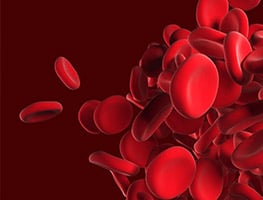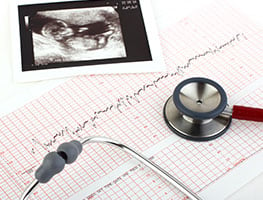During pregnancy there are also changes to the clotting tendencies of the blood, protecting a pregnant mother from developing uncontrolled uterine bleeding. Although this means her blood is more efficient at clotting, it also increases the risks of DVT. The compounds in the blood that normally keep anticoagulant ability at a healthy level also decrease. This combination of factors means that pregnant women are particularly vulnerable to developing DVT.
Although pregnancy increases the risk by 4- to 5-fold, the odds of having a DVT are still fairly slight. About one in every 1000 pregnant mothers will have issues with one.
Risk Factors in Pregnancy Increasing the Likelihood of DVT
-
Being overweight or obese
-
Smoking cigarettes
-
Being sedentary, sitting for long hours or being immobile
-
Bed rest for premature labour or threatened labour can be a risk factor – if the legs are not being used to help pump the blood back up towards the heart then pooling of blood in the lower limbs occurs
-
Having generalised problems with blood circulation
-
Having an operation during pregnancy or a caesarean section delivery
-
Having a history of DVT previously
-
Having a clotting disorder of the blood or a genetic abnormality in the blood clotting mechanisms of the body
-
Severe varicose veins of the legs or vulva
-
Being dehydrated which results in inadequate circulating blood volume
-
Having preeclampsia or generalised problems with blood pressure
-
Having a pregnancy complicated by other conditions or infection
-
Women over the age of 35 years are more at risk of developing DVT during their pregnancy
Why does it Happen in the Legs?
Simply because they are so far away from the heart. The muscles and veins of the legs need to work effectively and frequently to help return blood back up to the trunk and into the heart where it can be loaded up with oxygen again.
Sometimes the clot starts in the lower leg, but extends up into the large veins in the groin and the pelvis. It’s not until then that it is detected.
Signs and Symptoms of Deep Vein Thrombosis
Symptoms vary between individuals, though they can include any or all of the following:
-
The classic sign of DVT is an inability to put the heel to the ground because of acute pain.
-
Swelling of the ankles more than usual. This is particularly worrying if, in the morning after elevating the legs and feet all night, they are still swollen.
-
A localised redness in the leg, particularly in or around the calf muscles. Sometimes there is a skin colour change to a faint blue/red appearance.
-
A feeling of increased warmth or heat in an area of the leg or calf muscle.
Diagnosis is made by the clinical signs as well as a special ultrasound of the affected leg. The blood flow is measured into, out of and around the suspected clot and compared with normal levels.
What are the Dangers of a Deep Vein Thrombosis?
The real danger with a DVT is that part of it can break off from the rest of the clot and travel to the heart or the lungs, or even the brain. Blocking the blood flow and oxygen supply to any of these organs is a medical emergency. If it travels to the lungs this is called a Pulmonary Embolism (PE).
Signs of a Pulmonary Embolism
-
Shortness of breath, difficulty breathing and pain on breathing
-
Coughing up blood
-
Chest pain
-
Fainting and loss of consciousness
-
Racing heart
-
Breathing that is faster than normal
When Do I Need to be Careful?
-
Any time when you will be sitting or lying down for long periods of time and not walking around
-
During flights, when you may also be cramped and there is low cabin pressure
-
When your legs are swollen and there is a build-up of excess fluid around your feet and ankles
-
If you have not had enough to drink and are becoming dehydrated – this can happen during bouts of gastroenteritis or Hyperemesis Gravidarum when a mother becomes dehydrated
What Can I do to Prevent Getting a Deep Vein Thrombosis?
-
Drink plenty of fluids – around 2.5-3 litres of water each day is sufficient; more on very hot days.
-
Avoid sitting down for long periods. Get up and move. Go for a walk, swim, ride a bike – any activity which gets your blood flowing and avoids your legs being idle will help.
-
Avoid wearing tight or constricting clothing. Tight underpants, slimming or ‘shapewear’ pants, which “cut into” the groin and consequently the large artery supplying the legs are particularly risky.
-
Avoid crossing your legs.
-
Avoid sitting in cramped, restricted places. Public transport, long flights and long delays in waiting rooms are not advisable.
-
Your midwife or obstetrician may recommend you wear support hose, particularly if you have had a DVT previously.
-
Avoid drinking large amounts of caffeinated drinks such as tea, coffee and cola drinks. These can lead to dehydration which a major risk factor for DVT.
-
Don’t place a pillow or cushion under your calves, not matter how comfortable this is. Anything which restricts the easy flow of blood into and out of the legs can potentially cause problems.
-
If you work at a desk job or spend long hours at a computer, make sure your feet touch the floor. If you use a footrest, ensure your feet are resting on it, rather than dangling freely.
-
Make sure that when you sit on a chair, the seat edge does not finish behind your knees. Likewise, if you are sitting on a low stool, avoid letting the seat base come into contact with your calves.
-
Rotate your feet in a clockwise and counter clockwise direction for a few minutes every half hour. Go for a walk to the bathroom, do a few quick circuits of the floor you work on to get your blood moving through your body.
What is the Treatment for Deep Vein Thrombosis?
Once it is diagnosed, treatment needs to start immediately:
-
Anti-coagulant medication that is safe for the baby is given to the mother to help dissolve the clot, e.g. low-molecular weight heparin given through a subcutaneous injection.
-
Blood tests are taken regularly to monitor the levels of anti-coagulant and ensure these do not become too high. There is a risk of uncontrolled bleeding if the balance is not within safe parameters.
-
An elasticised compression stocking helps to manage swelling and support the leg veins to work as they need to. These can be a challenge to get on and off.
-
Stay as active as you can, as bed rest may increase your risk of the clot getting bigger.
-
Hospitalisation is frequently not necessary, but women with large clots are usually admitted.
Important Information to Remember
If you suspect you have a DVT, do not hesitate in getting medical assistance. Call an ambulance immediately for transport to the nearest hospital.



















